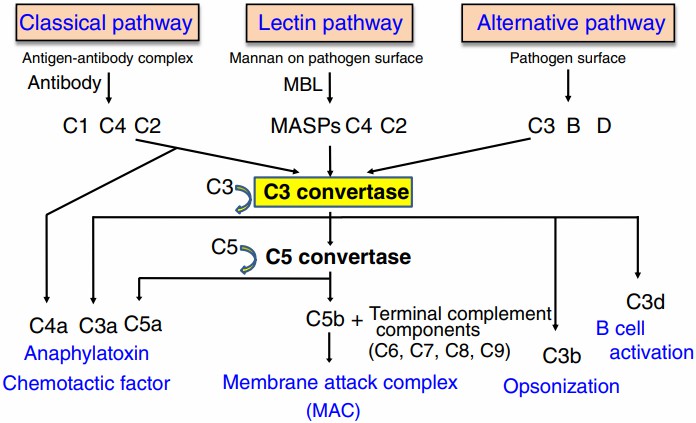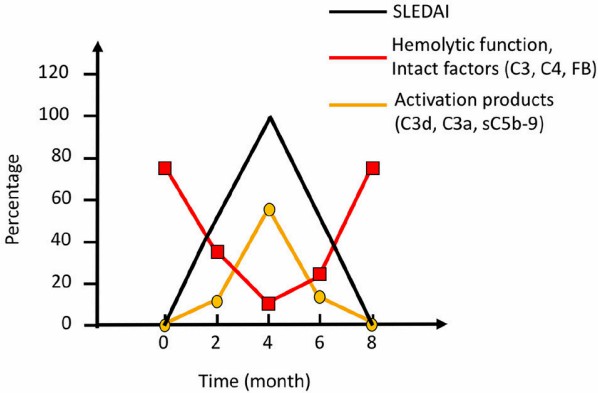NAA Services for Anti-C4
Complement component 4 (C4) is one important component of the complement system. Similar to other natural autoantibodies (NAA), detection of anti-C4 may be a symbol of some disease. Creative Biolabs can provide a full range of anti-C4 autoantibody marker services for diseases diagnosis and therapeutic monitoring based on our first-in-class technologies, years of experience and professional team.
Background of Anti-C4
C4 is a member of the complement system, which plays a critical function in human immunity and autoimmunity with the other numerous components. C4 is originated from the human leukocyte antigen system and important in connecting the recognition pathways of the overall system stimulated by antibody-antigen (Ab-Ag) complexes to the other effector proteins of the innate immune response. C4, comprising C4A and C4B, is a critical component that mainly participates in the classical, and mannose-binding lectin complement pathways. Due to its importance, investigations have been performed that C4 deficiency could lead to pathologic processes such as autoimmune disease and schizophrenia risk. Anti-C4 autoantibody directly against C4 shows a close association with autoimmune disease.
 Fig.1 The complement cascade is activated by binding of the C1 complex to the Fc stem of antibodies that form a complex with antigens.1
Fig.1 The complement cascade is activated by binding of the C1 complex to the Fc stem of antibodies that form a complex with antigens.1
The Role of Anti-C4 in Systemic Lupus Erythematosus
Autoimmune diseases are mostly caused by autoantibodies induced by an inefficient clearance of apoptotic cells and cellular debris, which abnormally serve as a source of autoantigens attack healthy tissues in our body-self. Systemic lupus erythematosus (SLE) is an autoimmune multisystem disease characterized by multiple autoantibodies and complement activation, including anti-C4 autoantibody. Various autoantibodies have been detected in SLE typically as anti-nuclear antibody, anti-double-stranded DNA, anti-rheumatoid factor, etc. Low serum complement activity or low protein concentrations of complement C4 causing SLE has been reported as early as 50 years ago. Increasing researches have demonstrated that both heterozygous and homozygous C4A or C4B deficiencies are pathogenic factors for SLE.
 Fig.2 Complement activation during an SLE.2
Fig.2 Complement activation during an SLE.2
Features of Our Services about NAA
- Well-established technology platforms
- Specialized scientists in antibody and NAA development
- Comprehensive NAA services including NAA detection, NAA profiling, and custom NAA products
- Abundant experience in NAA and related research
- High efficiency and best after-sale service
Creative Biolabs has long-term devoted to the investigations and applications of NAA, and anti-C4 is one representative autoantibody we have researched. Our optimized technology and scientific platforms are able to offer the largest and diversiform portfolio of NAA products, related applications and specifically custom services based on the requirements of the clients, which can help you get satisfactory results without repeated trials. If you are interested in NAA research, please feel free to contact us for more detailed information.
References:
- Horiuchi, Takahiko, and Hiroshi Tsukamoto. "Complement-targeted therapy: development of C5-and C5a-targeted inhibition." Inflammation and regeneration 36.1 (2016): 1-5.
- Ekdahl, Kristina N., et al. "Interpretation of serological complement biomarkers in disease." Frontiers in Immunology 9 (2018): 2237.
Related Services:
- NAA Services for Anti-Nuclear Antibody (ANA)
- NAA Services for Anti-Double-Stranded DNA (dsDNA)
- NAA Services for Anti-Smith
- NAA Services for Anti-Ribonucleoprotein (RNP)
- NAA Services for Anti-Ro Autoantibodies
- NAA Services for Anti-La Autoantibodies
- NAA Services for Rheumatoid Factor (RF)
- NAA Services for Anti-C3
- NAA Services for Anti-C1q

